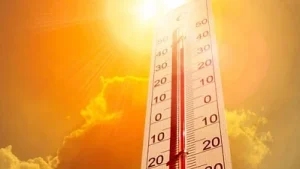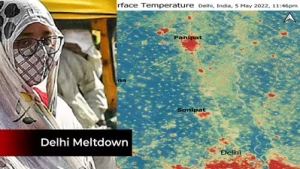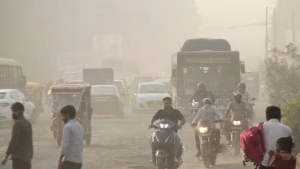New Delhi – The Delhi Heatwave reached unprecedented intensity on Monday as the national capital experienced its hottest day of the season, with the mercury soaring above 45 degrees Celsius across multiple locations. This latest Delhi Heatwave episode has pushed the heat index, or ‘feels-like’ temperature, to a punishing 49 degrees Celsius, creating extremely dangerous conditions for residents.
The India Meteorological Department (IMD) has responded to this severe Delhi Heatwave by issuing an orange alert for extreme heat conditions, warning citizens about the continued threat of dangerously high temperatures. This alert system reflects the severity of the current Delhi Heatwave and the potential health risks it poses to the population.
Weather Stations Record Dangerous Readings
Multiple weather monitoring stations across Delhi have documented alarming temperature readings during this Delhi Heatwave. IGNOU recorded the day’s peak temperature at 45.5 degrees Celsius, representing one of the highest readings during this season’s Delhi Heatwave episode.

Ayanagar closely followed with 45.3 degrees Celsius, while Safdarjung, the city’s primary weather observatory, reported 43.4 degrees Celsius—a full three degrees above the normal temperature range. The Delhi Heatwave has affected virtually every corner of the capital, with no area escaping the intense heat conditions.
Additional monitoring stations reported equally concerning readings during this Delhi Heatwave. Palam recorded 44.3 degrees Celsius, Ridge hit 44.9 degrees Celsius, and Lodhi Road registered 43.3 degrees Celsius, all contributing to the classification of official heatwave conditions across the region.
Humidity Amplifies Heat Impact
The current Delhi Heatwave has been particularly brutal due to the combination of extreme temperatures and oppressive humidity levels. While Delhi residents have grown accustomed to harsh summer conditions, this Delhi Heatwave has pushed discomfort to unprecedented heights through the dangerous combination of heat and moisture.

Humidity levels during this Delhi Heatwave have ranged from 25% to a stifling 70% throughout the day, significantly amplifying the heat’s impact on human comfort and health. This moisture retention has transformed the Delhi Heatwave from merely hot conditions into what experts describe as a pressure cooker environment.
Krishna Mishra, a weather scientist at IMD, explained the mechanics behind this severe Delhi Heatwave: “Despite hot westerly winds sweeping the region, moisture hasn’t left the air. That’s made the heat feel much worse.” The Delhi Heatwave has maintained its grip over Haryana, Chandigarh, and Delhi for consecutive days, with several areas consistently crossing 44.9 degrees Celsius.
Rising Heat Risk Concerns
Recent scientific research has highlighted Delhi’s vulnerability to extreme heat events like the current Delhi Heatwave. The Council on Energy, Environment and Water (CEEW) has identified Delhi among India’s top 10 districts facing ‘high and very high’ heat risk, making events like this Delhi Heatwave increasingly common and dangerous.


Vishwas Chitale, senior programme lead at CEEW, provided concerning insights about the evolving nature of the Delhi Heatwave phenomenon: “Humidity has gone up by 6-9% over the past decade. Combine that with rising temperatures, and the real-feel heat shoots up by 3-5 degrees.” This trend suggests that future Delhi Heatwave episodes may become even more severe.
The increasing frequency and intensity of Delhi Heatwave events reflect broader climate change impacts affecting the region, with urban heat island effects further exacerbating already dangerous conditions.
Extended Orange Alert Period

The IMD has extended its orange alert through Tuesday and Wednesday, indicating that the current Delhi Heatwave will persist for several more days. Maximum temperatures during this extended Delhi Heatwave period are expected to remain between 43 degrees Celsius and 45 degrees Celsius, maintaining dangerous heat conditions.
This extended Delhi Heatwave warning comes with additional concerns about air quality degradation. Dry and dust-laden winds forecast to blow from the west will likely worsen atmospheric conditions during the ongoing Heatwave, creating a compound environmental challenge for residents.
Air Quality Deterioration

The current Heatwave has coincided with significant air quality deterioration across the capital. On Monday, the city’s average Air Quality Index (AQI) spiked to 235, classified as ‘poor,’ representing a substantial increase from the previous day’s ‘moderate’ rating of 198.
This air quality decline during the Heatwave results primarily from coarse dust particles and elevated ozone levels, both exacerbated by the extreme heat conditions. The combination of poor air quality and intense heat during this Heatwave creates particularly challenging conditions for vulnerable populations.
Potential Relief on the Horizon
Despite the severity of the current Heatwave, meteorologists predict some relief beginning Thursday. The IMD forecasts light rain and thundershowers that may provide temporary respite from the intense Delhi Heatwave conditions, though temperatures are expected to remain elevated around 42-44 degrees Celsius.
More substantial relief from this Heatwave is anticipated from June 13, when cooler, moisture-laden winds from the Arabian Sea and Bay of Bengal are expected to bring down both temperature and humidity levels. This weather pattern change should effectively end the current Heatwave episode.
Public Health Implications
The extreme nature of this Heatwave poses significant public health risks, particularly for vulnerable populations including the elderly, children, and individuals with pre-existing health conditions. The combination of high temperatures and humidity during this Heatwave increases the risk of heat-related illnesses.
Authorities recommend that residents take appropriate precautions during this Heatwave, including staying hydrated, avoiding outdoor activities during peak heat hours, and seeking air-conditioned environments when possible.
Conclusion: Preparing for Climate Reality
The current Heatwave represents a stark reminder of the increasing intensity of extreme weather events affecting urban India. As such episodes become more frequent and severe, the capital must develop comprehensive strategies for managing future Heatwave situations while protecting public health and maintaining essential services during these challenging climatic conditions.

